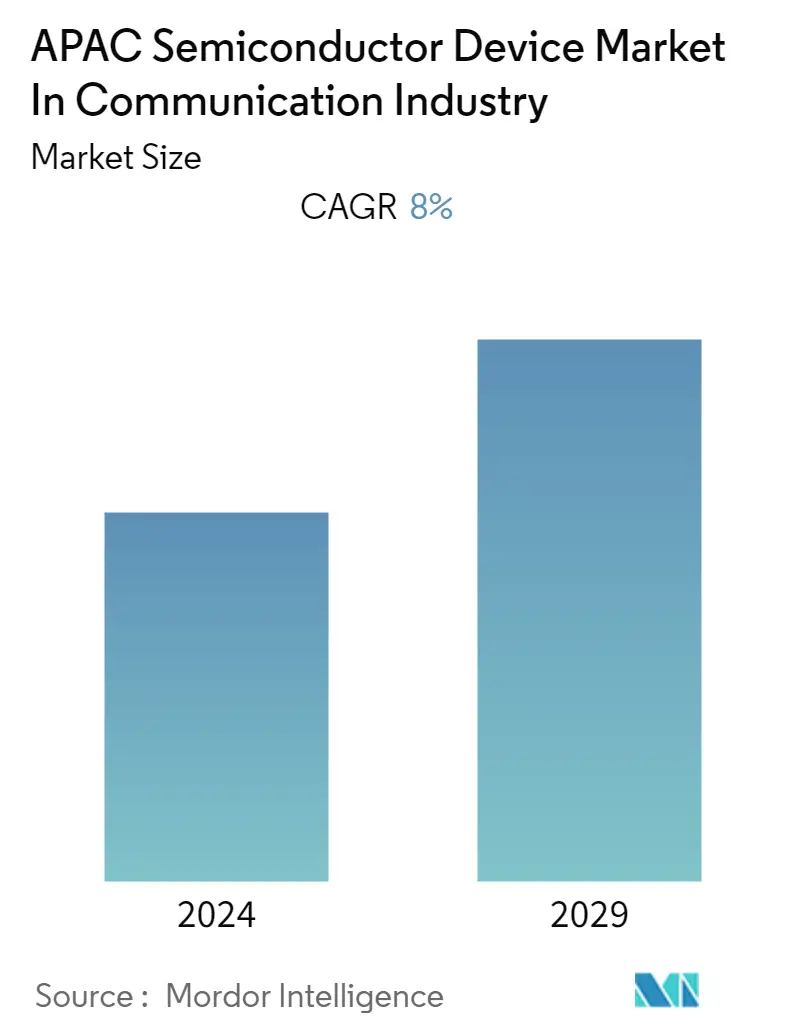Market Size of APAC Semiconductor Device Industry In Communication Industry

| Study Period | 2019 - 2029 |
| Base Year For Estimation | 2023 |
| Forecast Data Period | 2024 - 2029 |
| Historical Data Period | 2019 - 2022 |
| CAGR | 8.00 % |
| Market Concentration | Medium |
Major Players*Disclaimer: Major Players sorted in no particular order |
Need a report that reflects how COVID-19 has impacted this market and its growth?
APAC Semiconductor Device Market Analysis
Asia-Pacific Semiconductor Device Market in Communication Industry is valued at USD 133.37 billion in the current year and is expected to grow at a CAGR of 8.0% during the forecast period to become USD 195.96 billion by the next five years. The semiconductor industry is evaluated to continue its robust growth during the forecast period to accommodate the increasing need for semiconductor materials in rising technologies, such as artificial intelligence, autonomous driving, the Internet of Things (IoT), and 5G, coupled with competition among significant players and constant spending on R&D driving the market growth.
Most critical elements of modern telecommunication are built from semiconductor devices like MOSFETs, including mobile devices, base station modules, transceivers, routers, microprocessors, RF power amplifiers, memory chips, and telecommunication circuits.
In addition, network and communication chips are semiconductor integrated circuits (ICs) utilized in telecommunication gadgets and systems. Network and communication chips operate in many different technologies. Further, in June 2022, India carried on Chippagedon (the international chip shortage crisis) and aimed to bring semiconductor and display fab manufacturing to the country in the coming years.
Other PLI schemes are looking to accelerate domestic manufacturing of telecom and networking products. The supply chain and the logistics sector will play a vital role in meeting raw material demands for Indian manufacturers. In addition, 'Make in India' is an initiative by the Government of India to make and encourage companies to develop, manufacture and build products made in India and incentivize dedicated investments into manufacturing that may create effective demand in the studied market.
The increasing demand for data centers also boosts the demand for memory components. Large data center projects in the Asia Pacific contributed to the vital need for memory, such as DRAM. However, according to the standard of data-center space per user, China's internet data centers are balanced to at least 22 times that of the United States or at least ten times the current area of Japan. Hence, DRAM has a significant opportunity for growth and thus is impacting the semiconductor industry.
Furthermore, the rising proliferation of smartphones, feature tablets, and phones drives the studied market. Analog ICs are used in various applications, including third and fourth-generation (3G/4G) radio base stations and portable instrument batteries. RFICs are analog circuits that usually run in the frequency range of 3kHz to 2.4GHz (3000 hertz to 2.4bn hertz) circuits that work at about 1 THz (1tn hertz). They are widely utilized in cell phones and wireless devices. Due to such development, the analog IC demand in this communication industry may grow further.
Mobile internet penetration for the region is expected to escalate from 44% recently to 52% in 2025. This evolution is attributable to the anticipated surge in the number of mobile internet users in the region. Furthermore, the GSMA report indicates a significant jump of not less than 200 million latest sim connections from 2021 to 2025 in the region. This results in the sim card penetration rate from 100% to 105% in 2025.
Moreover, the ongoing semiconductor supply crunch could disrupt inventories for producing smartphones, routers, and IoT devices, impacting telecom operators' sales and service revenues.
The Asia-Pacific region was influenced by the interruptions to global supply chains forced by COVID-19 and geopolitical affairs, which influenced sourcing, manufacturing, distribution, logistics, and aftermarket services. Also, the geopolitical pressure between the United States and China has pressurized the region's IT instrument demand. However, the studied market continues to benefit significantly from the mobile environment. The growing population affecting the overall mobile subscription rate, vast mobile broadband scope, and market-leading 5G rollout are expected to impact the demand for mobiles during the forecast period.
